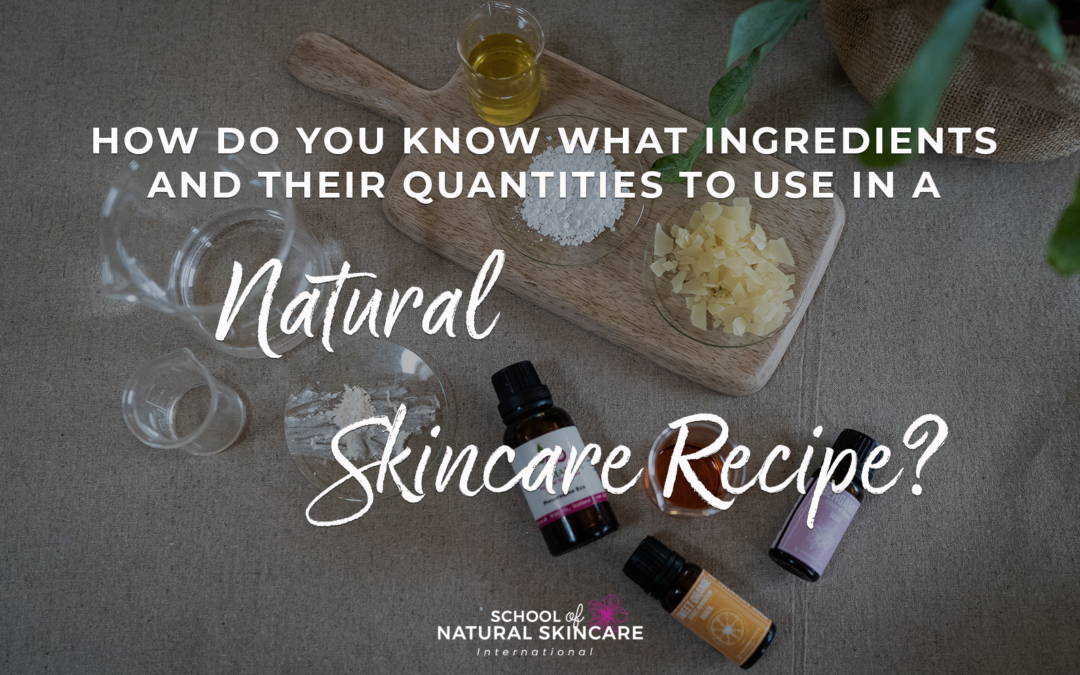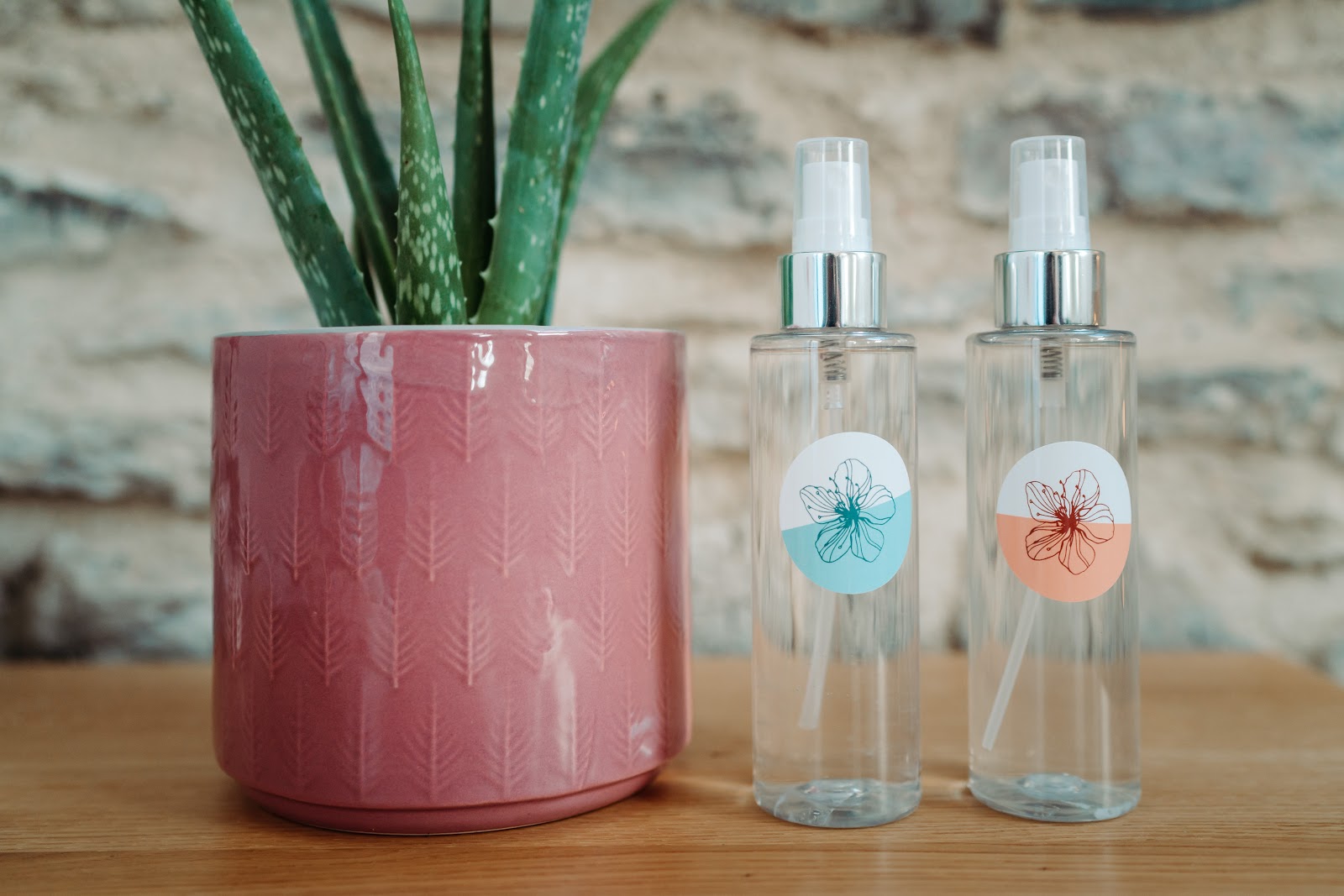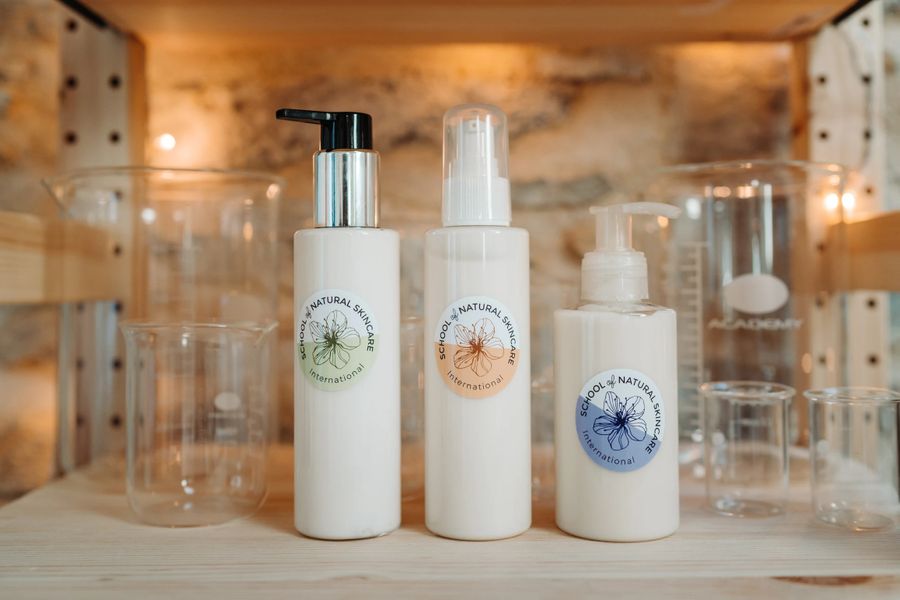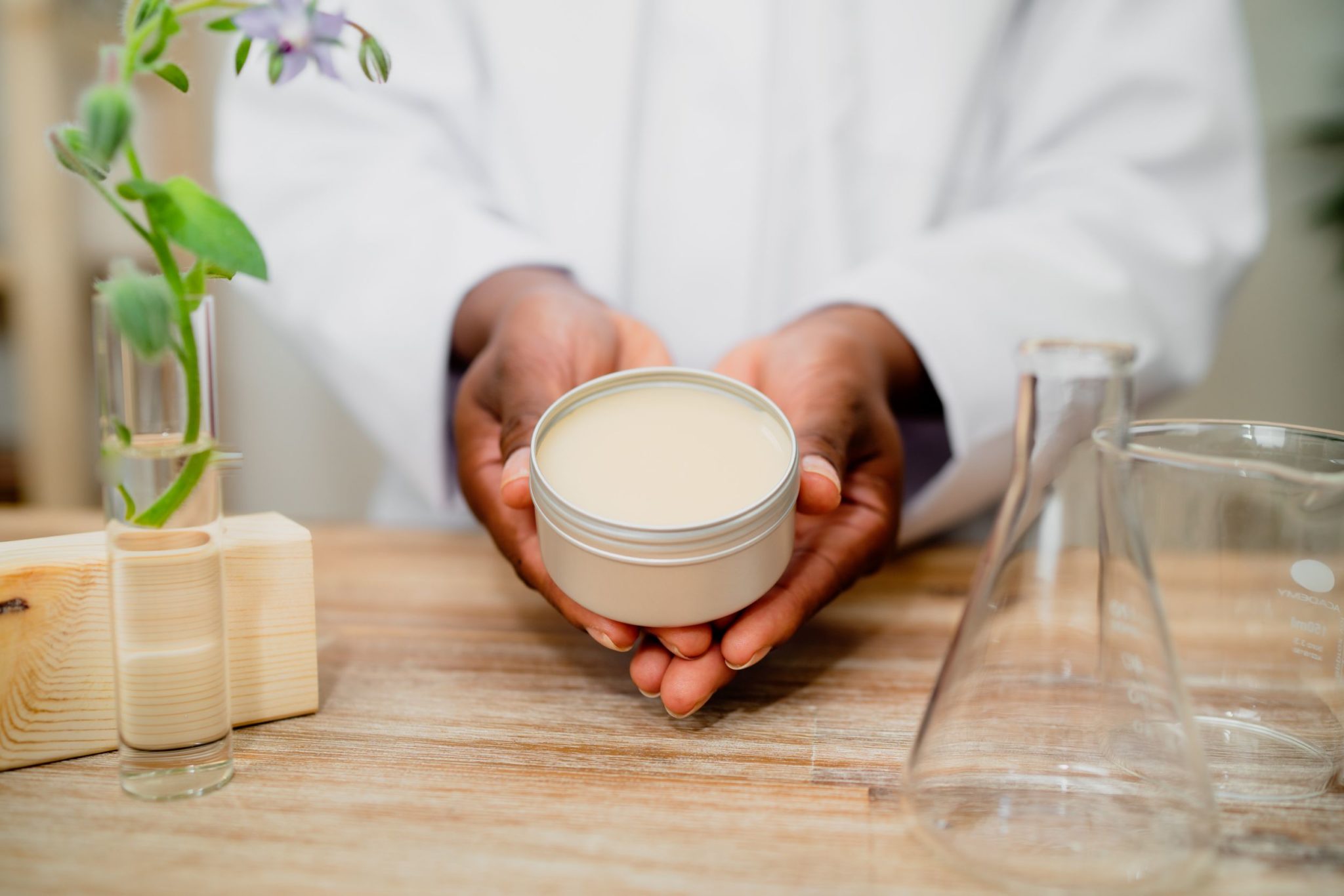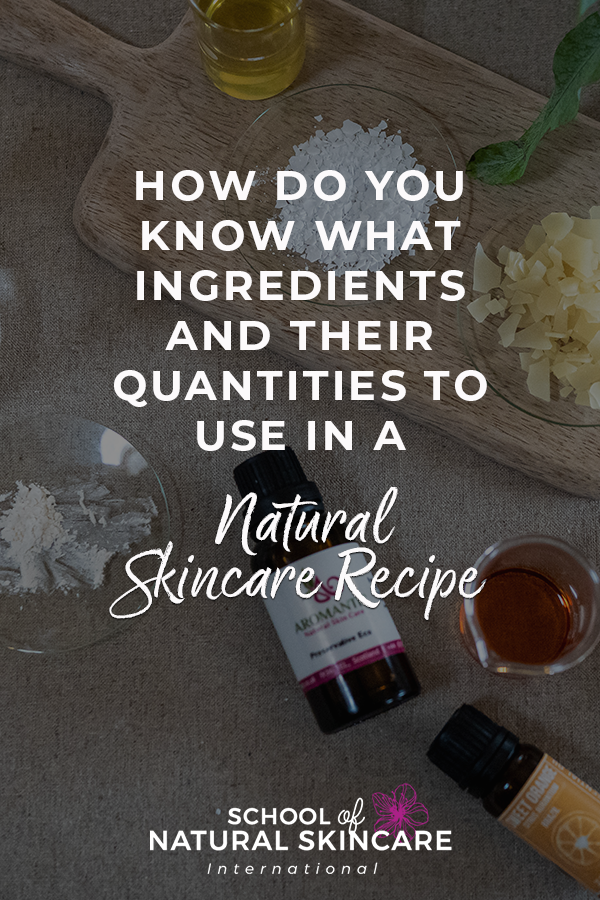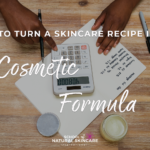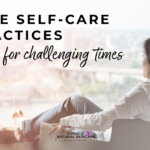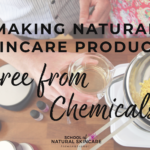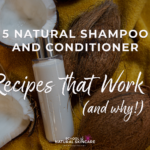You’ve even designed the packaging!
But when it comes to actually making a natural cosmetic product, how do you know what ingredients to use and how much?
How the type of natural cosmetic product you are making determines your ingredient choices
What ingredients to use depends on the product you are making. In the vast majority of cases, you will be making one of the three types of cosmetic products: anhydrous, water-based or emulsion.
Anhydrous products are usually the starting point for most DIY skincare product makers as they are simple to make; they contain no water (hence the name) and can take the form of lip balms, salves and lotion bars. Anhydrous balms are made with oils, butter and waxes, and so can’t contain any water soluble ingredients, since those won’t dissolve in oils. They can, however, contain oil soluble ingredients, like carrier oils, Vitamin E (an antioxidant) and essential oils.
Think toners, body spritzes and gels.
Water-based products can contain water (or water-based ingredients, like hydrosols), as well as water soluble ingredients, like panthenol or allantoin.
Lastly, there are emulsions, which are in between anhydrous and water-based products. Emulsions contain both oils and water, in a stable mixture.
Body lotions, facial moisturizers and hair conditioners are all examples of emulsions.
When selecting the ingredients for your natural skincare product, it is really important to decide on the product type first. Do you need water-based ingredients, oil-based ingredients or both? Will you need antioxidants, preservatives, emulsifiers, thickeners, stabilizers? And so on.
Making these decisions will help steer you in the right direction and make the right choices. So you’ve discovered the type of natural skincare product you need to make, but where do you go from there?
How do you select the right ingredients for your natural skincare product’s function?
Know your ingredients:
If you want to purposefully select the right ingredients, you’ll need to understand the properties, benefits and functions of different types of natural and organic cosmetic ingredients. To do this properly, you need to get to know your ingredients and have access to a library of accurate and up-to-date ingredient information.
This will help you to be able to make better and more informed choices.
Types of ingredient include: carrier oils, butters, waxes, essential oils, CO2 extracts, hydrosols, glycerites, powders, clays, thickeners, stabilizers, solubilizers, preservatives, emulsifiers, antioxidants and more.
In fact, students of our Diploma in Natural Skincare Formulation have access to a whole body of ingredient information during their studies and graduates tell us they use the course materials as a reference guide for years afterwards. We even dedicate a whole module to all the different categories of natural skincare ingredients.
Know the anatomy and biology of skin (or hair):
To better understand how ingredients affect skin, you’ll need to develop your knowledge of how skin (or hair) works, what it needs and what can be harmful to it.
Having a good understanding about the skin will give you the knowledge you need to be able to deliberately select the best ingredients for the right skin type and for the right skin concerns, without causing harm or irritation.
Our Diploma in Natural Skincare Formulation ensures students know everything they need to know to create their own unique, safe, stable and effective natural skincare products.
Follow the right product development methods:
Once you know the type of product you are making, have access to accurate information about a wide range of natural skincare ingredients, and know the anatomy and biology of the skin, you can make creating natural skincare products easier by following a professional product development process.
This is where you need to complete a product development brief – something we teach on our Diploma in Natural Skincare Formulation course. It is a simple process (once you know how) that will help you deliberately select the right ingredients and design your product on paper first.
The product development brief helps you to verify what you want to make, for whom, what skin type and concerns you want to address, and what the result is that you want to achieve.
After this process, you will have a clear picture of what ingredients your product needs.
You’ll discover which ‘base’ ingredients you will use, whether or not the product needs emulsifiers, preservatives, thickeners, etc, what stabilizers are most suitable for the product, which high-performance active ingredients it will contain, and so on. Our students tell us how invaluable this professional, but simple, process is.
Check out our article, How to formulate natural cosmetics that fly off the shelves to find out more about this process. It’s useful even if you only want to create products for yourself, family and friends!
Once all these processes are complete, you’ll end up with a list of ingredients that you will need for your product!
But how will you know how much of each ingredient to use that will ensure a safe, effective and desirable natural skincare product is created?
Learn to write professional cosmetic formulas:
A formula is the professional way to write what is essentially a skincare recipe. The biggest difference between a formula and a recipe is that in a formula the amount of each ingredient is written as a percentage.
Your formula also includes some key information about your product, such as the INCI name of the ingredients (the scientific or Latin name), the function of the ingredients, supplier, etc.
At this stage you’ll want to know how much of each ingredient to use to give you the result you want – viscosity, aroma, texture, skin feel, thickness, density, pH, color, etc. You’ll need to know their usage rates.
Different product types require different usage rates of certain ingredients.
For example, an anhydrous balm, like this lip balm, will contain only a small percentage of essential oil (0.5%), a high percentage of carrier oil (49.5%), and a reasonable amount of butter (20%) and wax (30%).
Additionally, students of the Diploma in Natural Skincare Formulation get a formulation template for each individual product type that tells them the recommended usage rates for each ingredient type. So we remove a lot of the guesswork and replace it with the correct formulation guidelines in line with industry standards.
How do you get started?
Creating custom formulations can be a difficult task, especially for beginners, but it can be a skill you learn with practice. In our Diploma in Natural Skincare Formulation, we provide example formulations for you to see what a typical example of a product would look like.
We also give you template formulations for you to use as a guide when writing your own formulation.
This way, the learning process is faster and easier, as opposed to just guessing the percentages of ingredients and learning by trial and error.
Once you have your formula in place, it is time to actually make the product. Often when you’ve made it, you’ll want to go back to your formula to tweak it to give it a different texture, look, feel, aroma, etc.
If you want to dip your toe into the world of formulating first, check out the Beginner’s guide to formulating natural skincare products – this contains a product development brief so you can see firsthand how it works. It isn’t the entire process and is just an example brief, but it will give you some ideas and get you started!
The full tuition and fast track to achieving the results you seek, is found by enrolling in the Diploma in Natural Skincare Formulation.
The beginner’s guide to formulating natural skincare products (from scratch, like a professional)!
The essential foundation you need to help you start creating your own natural skincare products from scratch rather than simply following recipes!
Download this fabulous guide and you’ll learn:
- What formulating is and why you need to be doing it!
- The difference between following recipes and formulating your own products.
- How to formulate like a pro! Seven top tips for becoming a confident skincare formulator.
- Our step-by-step process to designing products people love.
- Four easy ways to personalize your skincare products.
- Choosing the right carrier oils for your beauty products.
PLUS: TWO FREE WORKSHEETS!
- Our Cheatsheet Download: How professionals design skincare products (taken from our Diploma in Natural Skincare Formulation).
- Our Safe Product Checklist: How to make sure the skincare products you create are safe and stable.
Loved learning about this? Make sure to remember by pinning this article!

